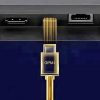by Alan Lofft, (bio), Axiom Audio
Our half-century-old analog TV system is gradually winding down, with the cutoff date for conversion from analog to digital TV in the USA now slated for somewhere around 2009. When this occurs, your old analog TV will no longer tune in terrestrial (over the air) TV stations unless you purchase an adaptor (there is talk of government subsidization of the analog-to-digital adaptors). According to accelerating growth figures cited for plasma, LCD and HDTV sales, you're by now likely considering replacing the old CRT behemoth in the corner with a big-screen HDTV or a slim wall-mounted flat-panel plasma or LCD. Keep the following in mind as you stroll through the electronics mega-stores or browse the Internet forums and web sites.
Know your HDTV resolution numbers (do the math).
The latest marketing hype tends to exaggerate the clarity of "1080p" HD sets, if only to keep consumers hungry for the latest and keep the factories humming with new models. True, 1080p is the highest possible screen resolution and clarity available, but virtually all existing HDTV material, including network HD broadcasts and those from satellite and cable-TV systems as well as terrestrial TV stations is in either "720p" or "1080i," which are the two High Definition TV standards. Prices are falling but 1080p sets still cost about $1,000 more than a good 720p HDTV. Both 720p and 1080i sets are capable of visually stunning HD images.
Avoid "480p" sets. These are not HD and are sometimes called "Enhanced Definition" (EDTV) but they are only capable of displaying standard DVD resolution, not HDTV detail and clarity.
Here are the resolution numbers to look for in any true HDTV display or projector. Just multiply the two figures together to find the total number of picture elements (pixels) a display is capable of:
A "1080p" set will state its resolution as 1920 x 1080p (that's about 2 million pixels, the highest available, and the most expensive).
A "720p" set's stated resolution will typically be 1280 x 720p (about 921,000 pixels).
Resolution figures may vary somewhat from the aforementioned figures with plasmas, LCD flat-panels and also front projectors, e.g. "1366 x 768," or "1024 x 768," but so long as they are close to the HD standard, then you have an HD-capable display.
By contrast, a set that has "852 x 480p" or "800 x 600p" is not HD. It will still look good with DVDs, but it won't deliver true High Definition images. Note that you'd still be able to view HD programs, but with reduced clarity and less detail. Do the math: 852 x 480p equals 408,960 pixels, less than half the number that a 1280 x 720p display will yield. The more pixels there are, the greater the potential detail and clarity from a video display.
For those who are considering purchasing one of the two new HD video disc formats — HD-DVD or Blu-ray — and who want to future-proof their HDTV purchase, then it makes sense to consider a 1080p set because movies in the new HD disc formats are mastered in 1080p, and some of the players will output those signals to 1080p-compatible HD displays over HDMI outputs. However, at this juncture it's anyone's guess as to which HD disc format will find favor with consumers.
And don't obsess if you don't get a 1080p-capable set. Your 720p or 1080i HDTV will still deliver a beautiful High Definition TV image.
You can save money on an HDTV if you find one that doesn't have a built-in HD tuner.
If you don't require an HDTV with a built-in tuner to receive local over-the-air HD broadcasts with an outdoor antenna, you may save money by searching for an "HDTV-ready" set that eliminates the internal HD tuner. These sets are scarce, because the Federal Communications Commission (FCC), which regulates the transition from analog to digital TV and HDTV, now requires that all new HDTV sets contain a built-in HD tuner. But the older models lacking one are typically less expensive than sets with built-in HD tuners or cable-card HD sets. Satellite dish systems and cable-TV providers normally supply (for a monthly fee or one-time purchase) the outboard HD tuner set-top box/DVR (Digital Video Recorder) required by their systems. These boxes/DVRs will tune in all the High Definition and Standard Definition channels available on the system, depending on which package of programming you buy. Newer HD cable or satellite boxes often contain two HD tuners plus a DVR, allowing you to record two different HD channels simultaneously, or watch one channel while recording another.
Bigger isn't always better – get a giant screen only if you have the appropriate viewing distance.
Calculate your estimated viewing distance from the screen to your couch in the room you are expecting to use for your home theater installation because that will determine how large a screen you should install and still get excellent image quality. Bigger is not necessarily better. If you get too large an HD display, and you sit too close to it, you may find the image "soft" i.e. blurry, or grainy and "pixilated." You should sit no closer than twice the diagonal screen size for true HDTV images. Put another way, if you estimate you'll be sitting 10 feet from the video display, then a 60-inch (5 feet) diagonal screen size with HD programs is the largest you should consider. If you are closer, get a 50-inch diagonal screen. Existing DVD resolution will look better from farther back, and Standard Definition broadcast TV looks best viewed up to three times the diagonal screen measurement. For front projectors, that means sitting 16 feet back from a 96-inch screen with HD sources; and greater distances for DVD and regular broadcast TV.
Consider a front projector only if you plan to watch your movies or TV programs in a darkened room.
Front projectors for HDTV have seen significant price drops–excellent HD models are available for $2000 to $3000 US–but whether they use DLP or LCD technology, they still have to throw light 10 to 20 feet across a room to create a big-screen image, so that image is intrinsically going to be dimmer to your eyes unless the room is dark, like a movie theater. If you have ambient light in the room, or prefer watching your movies with a room light on, the blacks, contrast and shadow detail will suffer. That's a compromise lots of viewers are willing to make because you can still get a huge image–96 to 120 inches diagonal is common. If that's the case, get a DLP front projector. They are capable of throwing a remarkably bright image. Because they're so compact (projectors are about the size of a major city's yellow pages), both projectors and screens can disappear completely into the ceiling when not in use.
If your room can't be totally darkened and you don't want to compromise on image quality, then consider a DLP or LCD rear-projection set (or LCD's cousin, LCoS). Those sets are available in screen sizes up to 73 inches diagonal and they will deliver a brilliant, high-contrast HD image in rooms that have ambient light. (Rear-projection sets get their "blacks" from the fact that the inside of the box is closed to light. Hence no internal reflections of light hit the screen, so blacks appear truly black. Rear-projection sets only have to throw the image a few feet inside their cabinet to the self-contained screen so they are intrinsically brighter than a front projected image.)
Although the newest flat-panel plasma and LCD sets are the most contemporary, sexy looking and least intrusive of new HDTV displays because they're so thin (about 3 to 6 inches), they are also the most expensive for a given screen size, typically costing $1,500 more than the same screen size in a DLP or LCD rear-projection set. So if you are on a budget and you have the room, forget the flat-panel plasma and get a 50-inch or 60-inch diagonal 720p DLP or LCD rear-projection HDTV for $1,800 to $2,500, respectively.
Finally, if dollars are really scarce, don't ignore the vacuum tube (CRT) video display. Admittedly it's a fading technology and limited to about a 36-inch diagonal maximum screen size, but it's proven over half a century and is capable of excellent picture resolution with vibrant colors and inky blacks. There are still a few digital models available at prices below $1,000. The downside, of course, is that these CRT sets are large and heavy, with a 34-inch weighing in around 200 pounds.
Whichever HDTV set you get, consider having it professionally calibrated for optimal picture quality or do it yourself with a special test DVD like the AVIA Guide to Home Theater or the Sound & Vision Home Theater Tune-Up DVD.
Repeat after me: "There is no best, there is no best."
Continue reading, A common sense guide to the HDTV display technologies.





























